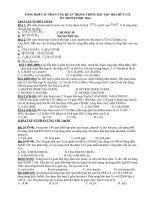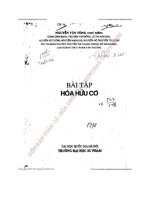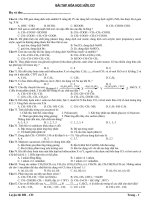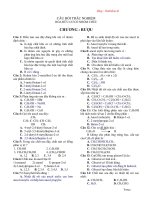- Trang chủ >>
- Sư phạm >>
- Sư phạm hóa
200 bài tập hóa hữu cơ (Two hundred exercises in mechanistic organic chemistry )
Bạn đang xem bản rút gọn của tài liệu. Xem và tải ngay bản đầy đủ của tài liệu tại đây (1.07 MB, 123 trang )
Two Hundred Exercises in
Mechanistic Organic Chemistry
© GalChimia, S.L., 2004
Two Hundred Exercises in
Mechanistic Organic Chemistry
Gabriel Tojo Suárez
Profesor Titular de Química Orgánica
University of Santiago de Compostela
4
5
Preface
Learning the mechanistic basis of Organic Chemistry is like mastering chess. In this game, one
needs to know how to move the pieces before embarking in a match. Similarly, a student in
Organic Chemistry begins by learning a list of simple reactions. This allows at a later stage to
explain the complex mechanisms that intervene in many organic reactions and consist in a chain of
simple reactions operating in a sequential way.
This book is aimed at students who have completed a learning cycle of Organic Chemistry and
need to settle their mechanistic knowledge. One of these students should be able to solve each
problem in about half an hour. A bachelor of Organic Chemistry should be able to do it in about
ten minutes, while a professional Organic Chemist should consume less than two minutes.
There is no way to scientifically prove that a certain mechanism is correct. A mechanism can only
be proved wrong. Mechanisms admitted as correct are those that explain the experimental data and
have been able to resist all attempts at proving their falsehood. On the other hand, only a few
simple reactions have been studied in detail from the mechanistic point of view.
The reactions depicted in this book are complex, and none have been studied in detail.
Consequently, the proposed solutions represent the opinion of author. Proposing a reasonable
mechanism is more relevant than hitting the right one. Many exercises admit more than one
sensible mechanism and the proposed solutions represent reasonable, but not unique, answers.
No enterprise would meet an end if the goal is the perfection. It is better to make soon a good job
than never a perfect one. Many people wait for the perfect moment to have children in order to
give them the best possible education. Often the resulting delay causes them to be biologically
unable to be parents. Bearing in mind that having children is so satisfactory that it is worth even in
a very imperfect way, I have written this book. I hope to be able to be proud of this intellectual
offspring in spite of its deficiencies.
Santiago, May 20th 2002
Gabriel Tojo
6
7
Contents
ABBREVIATIONS 9
EXERCISES 11
Chapter 1 Good-Leaving Groups on sp
3
Carbons:
Substitution and Elimination, Reactions of Simple Alkenes 13
Chapter 2 Additions to Aldehydes and Ketones 19
Chapter 3 Derivatives of Carboxylic Acids 29
Chapter 4 Conjugated Additions to Electron-Deficient Alkenes 41
Chapter 5 Reactions via Enols and Enolates 49
Chapter 6 Reactions via Carbanions Stabilized by
Functional Groups Other than Carbonyls 59
SOLUTIONS 61
Chapter 1 Good-Leaving Groups on sp
3
Carbons:
Substitution and Elimination, Reactions of Simple Alkenes 63
Chapter 3 Derivatives of Carboxylic Acids 83
Chapter 4 Conjugated Additions to Electron-Deficient Alkenes 99
Chapter 5 Reactions via Enols and Enolates 107
Chapter 6 Reactions via Carbanions Stabilized by
Functional Groups Other than Carbonyls 121
8
9
Abbreviations
15-crown-5 1,4,7,10,13-
pentaoxacyclopentadecane
Ac acetyl, CH
3
C(=O)–
B: base
Bn benzyl, PhCH
2
–
Boc tert-butoxycarbonyl, t-BuOC(=O)–
Bu n-butyl
t-Bu tert-butyl, Me
3
C–
cat. catalytic
Cbz benzyloxycarbonyl, BnOC(=O)–
conc. concentrated
CSA camphorsulfonic acid
DABCO 4-diazabicyclo[2.2.2]octane
DBU 1,8-diazabicyclo[5.4.0]undec-7-ene
DMAP p-(dimethylamino)pyridine
DMSO dimethyl sulfoxide, MeS(=O)Me
Et ethyl, CH
3
CH
2
–
HMPA hexamethylphosphoramide,
(Me
2
N)
3
P=O
KHMDS KN(SiMe
3
)
2
LDA lithium diisopropylamide, iPr
2
NLi
LHMDS LiN(SiMe
3
)
2
MCPBA m-choroperoxybenzoic acid
Me methyl, CH
3
–
MOM methoxymethyl, MeOCH
2
–
Ms mesyl, MeSO
2
–
NBS N-bromosuccinimide
Pd/C palladium on activated carbon
Ph phenyl
Piv pivaloyl, Me
3
CC(=O)–
PMB p-methoxybenzyl, p-MeOC
6
H
4
CH
2
–
PMP p-methoxyphenyl, p-MeOC
6
H
4
–
iPr isopropyl, Me
2
CH–
PPTS pyridinium p-toluenesulfonate
ref. reflux
rt room temperature
SEM 2-(trimethylsilyl)ethoxymethyl,
TMSCH
2
CH
2
OCH
2
–
TBAF tetrabutylammonium fluoride
TBDPS tert-butyldiphenylsilyl, t-BuPh
2
Si–
TBS tert-butyldimethylsilyl, t-BuMe
2
Si–
TES triethylsilyl, Et
3
Si–
Tf trifluoromethanesulfonyl (triflyl)
TFA trifluoroacetic acid
THF tetrahydrofuran
THP tetrahydropyran-2-yl
TIPS triisopropylsilyl
TMS trimethylsilyl, Me
3
Si–
Tol p-tolyl, p-MeC
6
H
4
–
Tr triphenylmethyl (trityl), Ph
3
C–
Troc 2,2,2-trichloroethoxicarbonyl
Ts p-toluenesulfonyl, p-MeC
6
H
4
SO
2
–
10
11
EXERCISES









